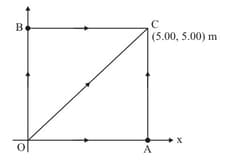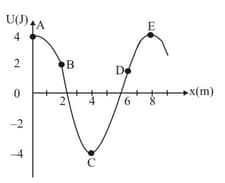The potential energy of a particle in a certain field has the form where and are positive constants and is the distance from the centre of the field. Find the value of corresponding to the equilibrium position of the particle; examine whether this position is stable.

Important Questions on Work, Energy and Power
A particle of mass is free to move along axis under influence of a conservative force. The potential energy function for the particle is given by
Where and If the total mechanical energy of the particle is zero,
(a) Plot this potential energy function, identify the regions where particle may be found
(b) Calculate the maximum speed of the particle.
A particle moves in the plane in figure under the influence of a friction force with magnitude and acting in the direction opposite to the particle’s displacement. Calculate the work done by the friction force on particle as it moves along the following closed paths:
(a) path followed by the return path
(b) path followed by and the return path
(c) path followed by the return path
(d) each of your three answers should be non-zero.
What is the significance of this observation?
For the potential energy curve shown in figure. Determine whether the force is positive, negative, or zero at the five points indicated.



